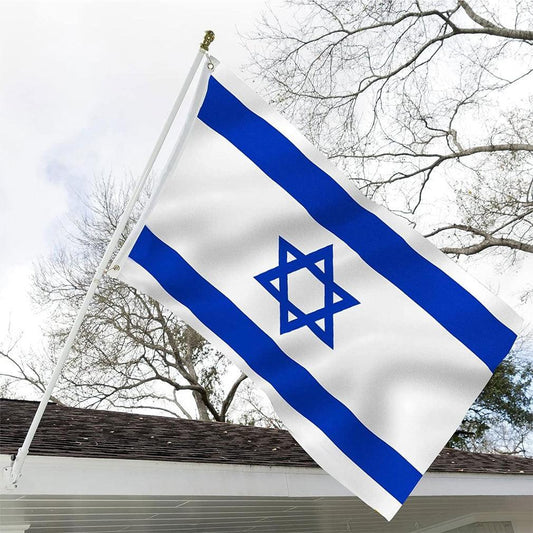-
Israel Sweatshirt
Regular price $34.15 USDRegular priceUnit price / per -
Israel Flag Sweatshirt
Regular price $34.15 USDRegular priceUnit price / per -
Israel Inspired Sweatshirt
Regular price $34.15 USDRegular priceUnit price / per -
Israel Pillow
Regular price $22.65 USDRegular priceUnit price / per -
Israel Backpack
Regular price $59.79 USDRegular priceUnit price / per -
Israel Leather Patch Hat
Regular price $18.85 USDRegular priceUnit price / per -
Israel Mug
Regular price $11.65 USDRegular priceUnit price / per -
Israel Trucker Cap
Regular price $14.90 USDRegular priceUnit price / per -
Israel Hoodies
Regular price $34.40 USDRegular priceUnit price / per -
Israel Inspired Hoodie
Regular price $34.40 USDRegular priceUnit price / per -
Israel T-shirts
Regular price $22.79 USDRegular priceUnit price / per -
Israel Flag Hoodies
Regular price $34.40 USDRegular priceUnit price / per -
Israel Inspired T-shirt
Regular price $22.79 USDRegular priceUnit price / per -
Israel Flag on T-shirt
Regular price $22.79 USDRegular priceUnit price / per -
Embroidered Israel Flag 3x5ft – Double-Sided for Outdoor Display
Regular price $58.74 USDRegular priceUnit price / per
Collection: Israel
The Israel flag symbolizes the nation's identity and history, with its unique design and colors holding deep meaning for its citizens. We will explore the various aspects of the Israel flag, including its design, historical context, symbolism, current relevance, and additional interesting facts.

Overview of the Israel Flag's Design and Colors
The visual aesthetic of the Israel flag is simple yet profoundly meaningful, incorporating a central motif flanked by horizontal bands. At the heart of the design is the blue Star of David, an iconic emblem of Jewish identity and heritage. This six-pointed star is set against a stark white background, creating a striking and symbolic contrast. Two blue stripes that run parallel to the flag's top and bottom edges complement the star.
These bands draw inspiration from the tallit, a traditional Jewish prayer shawl, further embedding the flag with religious and cultural significance. The color scheme of blue and white not only echoes the hues found in the tallit but also serves as a visual representation of the values and aspirations of the Jewish people. This thoughtful combination of elements and colors makes the Israel flag a powerful emblem of national pride and historical continuity.
Historical Context of the Israel Flag
The flag of Israel was officially adopted on October 28, 1948, mere months after the nation declared independence on May 14, marking a pivotal moment in Jewish history. This significant act of establishing the flag came during the Israeli Declaration of Independence, signaling a new era for the Jewish people who had sought a homeland for centuries. The design was inspired by the Zionist movement's flag, which reflected Jewish aspirations and identity and was first displayed at the First Zionist Congress in 1897. The Zionist flag, which laid the groundwork for the national flag, featured the same blue and white colors, along with the Star of David, aiming to symbolize the Jewish community's unity and the continuity of their heritage.
Over the years, the flag has stood unchanged, a testament to the enduring spirit and resilience of the Israeli state and its people. Its adoption was not only a statement of national identity but also a declaration of the values and hopes of the nascent state. The flag's inception is intertwined with the region's tumultuous history, reflecting the struggles and triumphs faced by the Jewish people in their quest for sovereignty and peace. The flag's establishment shortly after Israel's independence underscores its integral role in forming and expressing the country's national identity as a constant reminder of the historical journey and aspirations of the Jewish people.
Symbolism Embedded in the Israel Flag

The Israel flag's symbolism extends deep into Jewish history and spirituality, each element carefully chosen to represent facets of Jewish identity and faith. The Star of David, positioned centrally on the flag, is a potent symbol of Jewish heritage. Historically, it has been used as a shield emblem dating back to medieval times, embodying protection and a sense of unity among the Jewish people. This emblem encapsulates the resilience and enduring spirit of Judaism.
The flag's color scheme, blue and white, further deepens its symbolic significance. These colors were selected for their traditional association with Jewish prayer garments, specifically the tallit, adorned with blue stripes and worn during prayer services. Including these colors on the flag is a continuous reminder of the spiritual and religious foundations of the Jewish people. Moreover, in ancient Jewish tradition, blue and white were historically considered royal colors, symbolizing purity, peace, and divine presence.
This thoughtful integration of symbols and colors on the flag not only reflects the rich tapestry of Jewish tradition and belief but also signals the Jewish state's aspirations for peace and unity. The flag is a visual testament to the Jewish people's centuries-old quest for self-determination and enduring hope for a peaceful future.
Current Relevance of the Israel Flag
Today, the Israel flag remains central to the country's civic and cultural life. It is ubiquitously seen during state ceremonies and proudly flown over public institutions. It is an integral part of military commemorations, symbolizing not only national identity but also the collective memory and resilience of the Israeli people. In the global arena, the flag represents Israel at international forums, sports events, and diplomatic engagements, symbolizing the nation's sovereignty and active participation on the world stage.
Despite its widespread acceptance and use within the country, the flag sometimes sparks debate and discussions, particularly concerning its representation and inclusivity. These discussions often reflect broader societal dialogues about the nation's identity, values, and the state's future direction. As such, the Israel flag remains not just a national emblem but a focal point for conversation and reflection about the state of Israel and its diverse society.
Additional Facts About the Israel Flag
The protocols surrounding the Israel flag are steeped in respect and tradition, underscoring the country's reverence for national symbols. One of the most stringent rules is the mandate that the flag must never be allowed to come into contact with the ground, reflecting the deep respect and honor accorded to it. This guideline mirrors practices found in many cultures, where the national flag is treated with the utmost care to maintain its dignity and sanctity.
Beyond its primary design, the Israel flag's influence extends to other official banners. The nation has distinct variations for maritime use, including a naval ensign and a civil ensign. These variations maintain the core elements of the national flag while adapting them for specific ceremonial and operational purposes. Each variation serves a unique role, further embedding the flag's symbolism within different facets of Israeli society and governance.
An interesting aspect of the flag's design is its reliance on religious symbols, making it one of a relatively small number of national flags globally that incorporate such symbolism directly into their designs. This choice highlights the intricate link between the state's national identity and its religious heritage, showcasing the profound connection that exists between the country's cultural foundations and its contemporary expressions of national pride.






























